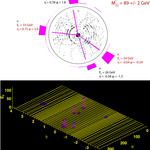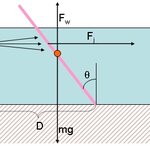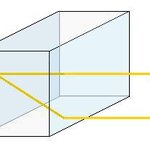Physics

A video on youtube documents a remarkable feat -the Australian motorbyker Robbie Maddison jumping the Korynth channel in Greece. A 85-meter jump!
I am interested to explain in simple terms the kinematics of the problem. The speed he reached when he left the starting ramp was, I am told, 125 kilometers per hour. That is about 35 meters per second. It is a simple exercise to compute what is the length of the jump, if we assume that the angle at the start of the parabola is 45 degrees -the angle which, in the absence of friction with air, guarantees the longest jump.
We write the equations for…

I was on a plane to Valencia yesterday at the time when Paolo spoke in the Main Auditorium at CERN, and got approved our very first physics result with CMS collider data.
Okay -with a small group we had already produced an approved plot of phi-->KK decays last December, but this is a real, full-fledged analysis! I will talk more about it in the next few days.
Russian and US physicists have created a superheavy element made of atoms containing 117 protons that is roughly 40% heavier than lead. The achievement fills in the final gap on the list of observed elements up to element 118.
The team produced the elusive element 117 by fusing together atoms of calcium and another rare, heavy element known as berkelium. The research will appear in a forthcoming issue of the Physical Review Letters.
Like all superheavy atoms, element 117 is unstable, lasting only fractions of a second before self-destructing in a cascade of lighter elements and…

A lot has been going on recently in blogs I sporadically visit (I am not a big reader myself). I thus thought I'd put together a list of valuable links here.
First of all, Michael Schmitt deserves at least three links. He has been blogging much more intensively in the last few months than he used to earlier, and this is a great thing because he is a clear thinker and a careful writer. Let me mention his recent post, "Why particle physics", a discussion of the reasons for pursuing our science which started from comments in an article on the NTY; his informative discussion of the LHC…

I just read a very nice article by Nature's Zeeya Merali, and I thought I would link it from this blog. It discusses in detail several aspects of the sociology of the very large communities of particle physics experiments taking place at CERN.
At some point the article mentions blogs, and the problem these and similar communication means pose to the cohesion of the collaborations. However, Zeeya does not fully explore the topic. A pity, because I believe it will be one of growing importance. For a discussion of the matter, give a look at the writeup of a talk I gave at WCSJ 09 in London last…

The CDF Collaboration blessed yesterday afternoon the results of a search for massive Gravitons decaying into pairs of Z bosons. And it is a startling new result!
Usually after a blessing (which is the result of a collaboration-wide presentation when the analysis is given a final scrutiny) the results are not immediately made public: this non-written rule has the purpose of allowing the analysis authors to be the first to present the results at a conference or other public event. But the rule written in the CDF bylaws, on the other hand, say that after a blessing the result is public, so for…

The formulation of a fun physics problem with practical -and pleasant- applications occurred to me yesterday. I am currently spending a week in Madrid with my family, and we have chosen a very nice hotel in the suburbs, sacrificing travel time to the center for comfort. Among other things, the hotel offers a nice pool with several water jets along the sides. These are meant to allow you to swim against the water stream, so that you keep the same position as you push yourself against the stream.
I found a better use of the stream. By standing in the 4' deep water with my back facing the water…

Birefringence and the polarized light
1. Definition
Birefringence is a kind of optical phenomenon that when the light go through an anisotropic crystals, there are two emergent refracted lights as the different refractive index along directions. The light obey to the Snell’s law is known as the ordinal (o) ray, while the other one is known as extraordinal (e) ray, as shown in Fig. 1 [1]. The direction of o ray vibration is perpendicular to the incident plane, while that of e ray is in the incident plane. Fig. 1 Schema of birefringence [1]For birefringence, we first should know that it…
We are on. This afternoon just after 1PM the LHC beams have started to produce proton-proton collisions in the heart of the experiments, at the never-before achieved energy of 7 TeV.
It was a long journey to get here -the project is twenty years old- but this is just the start of a new, more exciting one: In the course of the next two years, the Large Hadron Collider will gradually increase its power, allowing the CMS and ATLAS detectors to collect enough data to significantly extend into discovery territory.
No, results are not going to come out tonight -no more than black holes are not…

So how dangerous is the Large Hadron Collider? How likely is it that when operated at maximum energy the LHC will create a black hole and wipe out earth? Eric Johnson, assistant professor of law at the University of North Dakota and author of the report The Black Hole Case: The Injunction Against The End Of The World, writes in a recent edition of New Scientist:
“Up until now, the various lawsuits filed against the LHC have faltered. But if the right kind of claim is filed in the proper court, a judge may soon have to face the question of whether an injunction might be needed to save the…